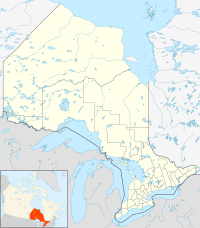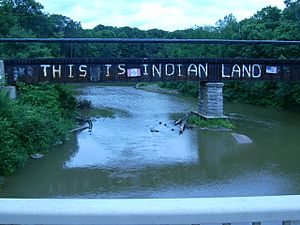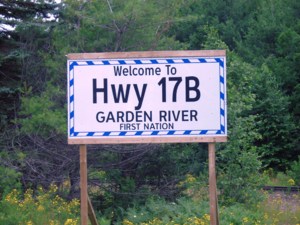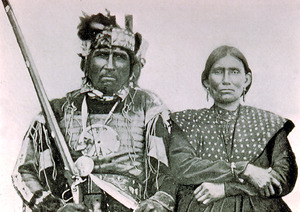Garden River First Nation facts for kids
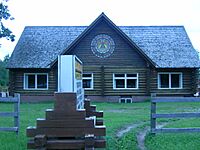
Shke-Sahkehjewaosa Community Centre
|
|
| People | Ojibwe |
|---|---|
| Treaty | Robinson Huron Treaty & Pennefather Treaty |
| Headquarters | 7 Shingwauk Street, RR 4, Garden River |
| Province | Ontario |
| Land | |
| Main reserve | Garden River 14 |
| Land area | 207.04 km2 |
| Population (2023) | |
| On reserve | 124 |
| On other land | 61 |
| Off reserve | 2073 |
| Total population | 3398 |
| Government | |
| Chief | Karen Bell |
| Council |
Kari Lynne Barry
Darwin Belleau Lee Ann Gamble Kristy Dawn Jones Travis Jones Chester Langille Luanne Povey Candice Sim |
| Tribal Council | |
| Anishinabek Nation Mamaweswen, The North Shore Tribal Council |
|
| Website | |
| https://www.gardenriver.org/site/ | |
|
Garden River 14
Gitigaan-ziibi
|
|
|---|---|
| Garden River Indian Reserve No. 14 | |
| Country | |
| Province | |
| District | Algoma |
| First Nation | Garden River |
| Area | |
| • Land | 215.20 km2 (83.09 sq mi) |
| Population
(2011)
|
|
| • Total | 1,107 |
| • Density | 5.1/km2 (13/sq mi) |
| Time zone | UTC-5 (EST) |
| • Summer (DST) | UTC-4 (EDT) |
Garden River First Nation, also known as Ketegaunseebee, is a community of Ojibwe people located in Ontario, Canada. Their traditional name, Gitigaan-ziibi Anishinaabe, means "Garden River People" in the Ojibwe language. They live on a special land called Garden River 14, which is near the city of Sault Ste. Marie, Ontario.
The Garden River reserve is made up of two separate areas. Together, they cover about 207 square kilometers. The main part of the reserve is located along the St. Marys River and Highway 17. The Garden River flows through the reserve and into the St. Marys River. The reserve shares borders with other areas like Sault Ste. Marie and even Sugar Island Township, Michigan in the USA.
Garden River First Nation is led by a group called the band council. This council includes a chief and eight councillors. They hold elections every two years to choose their leaders. The current chief is Karen Bell.
Contents
History of Garden River First Nation
The Robinson Huron Treaty
Garden River First Nation became a legal community after a special agreement called the Robinson Huron Treaty. This treaty was approved on November 29, 1850. It was negotiated between the British colony's representative, William B. Robinson, and many Ojibwe chiefs. They signed the treaty on September 9, 1850.
The treaty meant that the Ojibwe people gave up some of their land rights. In return, they received 17 reserve lands and yearly payments called annuities. The amount of these payments depended on how many people were registered as band members.
Garden River First Nation was represented in this treaty by Shingwaukonse. He was a respected Ojibwe grand chief. Shingwaukonse and his community had been living at their traditional garden lands near the mouth of the Garden River since 1841. The treaty officially recognized their land as Reservation 14.
After Shingwaukonse passed away in 1854, his son Augustine Shingwauk became chief. Later, Shingwaukonse's second son, Buhgwujjenene, became the last hereditary chief.
Land Agreements and Changes
The treaty described the Garden River reserve as land from Maskinongé Bay to Partridge Point, extending ten miles inland, and also including Squirrel Island. For many years, Garden River First Nation disagreed with how their reserve was surveyed.
In April 2003, the Canadian government returned about 3,492 hectares of land to the reserve. This land came from nearby areas called Anderson and Chesley. This agreement was made between the First Nation, the Canadian government, and the province of Ontario. Ontario also gave up its rights to any minerals found on this returned land. This meant the band could benefit from these resources.
Cultural Connections
In 1855, a visitor named Johann Georg Kohl wrote about his visit to "Rivière au Désert," which means "Garden River" in French. He shared a Nanabozho story he heard there about the "Beaver King." Kohl also admired beautiful art made from birch bark biting.
In 1964, Garden River First Nation hosted an important meeting for the National Indian Council. Indigenous representatives from all over Canada gathered in the community's meeting hall, which was called Sahkahjewadsa, meaning "House of the Rising Sun."
Highway 17 Dispute
Highway 17, a major road in Canada, was changed in 2007. A new four-lane road was built north of the old one. The old road was renamed Highway 638, but the Garden River community did not agree with this. They put up their own signs calling the old road "Highway 17B."
The nearby cities of Sault Ste. Marie and Macdonald, Meredith and Aberdeen Additional supported Garden River's decision. In 2009, the government of Ontario finally agreed. They officially named the old road Highway 17B.
In 2010, the Garden River band council warned that they might charge tolls on both Highway 17 and Highway 17B if the government didn't help them with a money problem. They were protesting a new tax called the Harmonized Sales Tax (HST) that Indigenous people had to pay.
Population and Community
As of June 2006, Garden River First Nation had 2,134 registered members. About 1,004 members lived on the reserve. The other 1,130 members lived off the reserve, many of them in Sault Ste. Marie.
According to a 2001 census, more than 45% of the people living on the reserve were under 25 years old. Most people (over 93%) spoke only English at home. Many identified as Catholic (over 56%) or Protestant (28%).
Transportation
Ontario Northland provides bus service to Garden River. Buses travel between Sault Ste. Marie, Sudbury, North Bay, and Ottawa. There is one bus each day going east and one going west, from Sunday to Friday. There is no bus service on Saturdays.
Notable Members of Garden River First Nation
Many talented people come from Garden River First Nation:
- Jordan Nolan – A professional hockey player who won the Stanley Cup three times.
- Shingwaukonse – A respected Hereditary Chief and warrior. He fought in the War of 1812 and was a strong supporter of education.
- Ted Nolan – A former professional hockey player and coach. He won the NHL Coach of the Year award in 1996–97.
- Brandon Nolan – Another former professional hockey player who played for the Carolina Hurricanes.
- Darren Zack – A famous softball player. He is in the International Softball Congress Hall of Fame and won four world championships. He also helped Canada win three gold medals at the Pan American Games.


